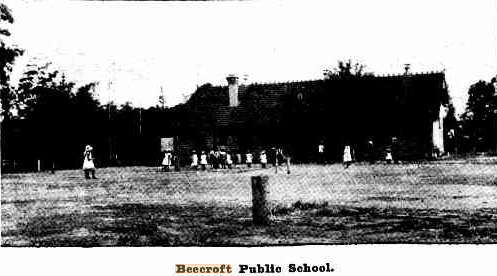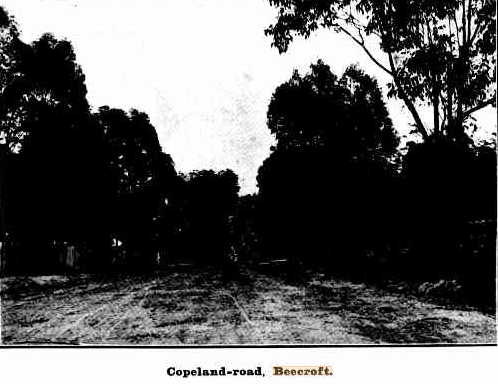Australian Town and Country Journal (Sydney, NSW: 1870 – 1919), Wednesday 5 May 1909, page 20
BEECROFT.
BY R. C.
he pretty little town of Beecroft is situated on the main Northern line. Just 17 miles from Sydney, or three miles beyond Epping, referred to in a recent issue. It was originally known, as Murray Farm Estate, but when the railway station was opened on the completion of this section of the Northern line, it was christened Beecroft by the then Minister for Lands, the Hon. Henry Copeland, that having been his wife’s maiden name. The first settlement took place in 1883—26 years ago— when the Northern line was in the course of construction, among the early pioneers being Messrs. J. Murray, J. Stewart, J. Jordan, W. Martin, and C. Churchill Tucker, all of whom embarked in the fruit growing industry, and did well too, despite the inconvenience of transit. Others soon followed, and the first land sale took place on July 9, 1887, a fair-sized area being disposed of. The first allotment sold was purchased by Mr. J. H. Parker, and the first brick cottage erected in the place was built to the order of Mr. C. Churchill Tucker, and known as “Plympton,”
Twhich stands upon the well-known and famous orchard of that name.
Preparatory to the land sale referred to some 800 of the unemployed were sent up from Sydney to under-scrub the land and clear the roads. For a time, further settlement was retarded, owing to there being only three trains a day, the last leaving Sydney at 4.23 p.m., though that was a great improvement as compared with the time when there were no trains at all, and the settlers had to travel to Sydney, via Parramatta, journeying to and from the latter place by vehicle. However, an improvement on the three trains a day service was brought about after two years, with the result that a few good villa residences soon made their appearance,” Mr. W. Perdriau and Mr. W. G. Coward being, among the first of the later-day new residents to cast their lot in Beecroft. Upon the completion of the duplication of the line, to Hornsby, settlement became more marked, though still gradual, but with the extension to the district of the water service, and, later still, the gas service, and the acquisition of ether conveniences, the place advanced in leaps and bounds, until to-day there is a population of 1100 souls or more within half a mile radius of the station, while there are upwards of 300 houses within that area. A distinctive feature of modern Beecroft is that its dwellings and villa residences are of a superior type, some of them costing thousands of pounds sterling to construct, and all, with but few exceptions, occupying comparatively large areas. This latter fact, and the hilly nature of the country, together with the circumstance that the native trees have been largely preserved, have combined towards the retention of an appearance of rusticity that has its own special charm; and, added to this; its elevation, which is 427 feet above the sea level at the station, rising to 600 feet at Red Hill, renders it extremely healthful, and enables its denizens to enjoy an extensive panoramic view embracing the city, which on a clear day is plainly visible. At Thompson’s Corner, the extreme north-western boundary of Beecroft, the view is very fine indeed, unfolding a panorama of the Blue Mountains to the west, and some splendid coastal scenery towards the east. The deep gullies on the eastern-side of the railway line, at Beecroft, remind one very much of Blue Mountain scenery; some of the many ravines being quite as extensive, and sassafras and tree ferns being very abundant.
The first church built in; Beecroft was St. John’s, C.E., erected in 1888, on the main road, and subsequently removed to a more central site. A larger church was recently built to take its place. This fine edifice cost £1600, exclusive of the land, and has seating accommodation for about 400. The foundation-stone was laid by Admiral Sir Harry Rawson. There are two other places of worship, the Methodist Church, opened about two years after St. John’s, and the Brotchie Memorial Church (Presbyterian denomination), opened only a few weeks ago, under very favourable auspices.
The foundation-stone of the pretty little school of arts was laid by Miss Doris Tucker, on September 17, 1904, and the building was opened six months later by Sir Harry Rawson, the debt being £500, which has since been liquidated, and it is now in contemplation to increase the accommodation by an expenditure of about £1100. The first educational institution was a private school, inaugurated by Miss Ogden, 14 or 15 years ago. Sometime after that the Beecroft Public School was opened, Mr. Fuller being the first schoolmaster. He was succeeded by Mr. J. I, Forsyth, under whose guidance the school has made marked and rapid progress— many of its scholars having gained creditable distinctions. There are several private schools, a literary and debating society (with lady orators), and an orchestral and dramatic society (Mr. McKern conductor). In the matter of outdoor recreation, Beecroft is well provided for. The Kennedya Lawn Tennis Club was established about 12 years ago, and its three courts may be ranked as among the best in the suburbs. A cricket and general recreation ground, embracing an area of 6 acres, at Develin s Creek, was purchased some years ago, at a cost of £300, and its golf links, on the Pennant Hills-road, are among the prettiest in the country. The village green as one of Beecroft’s most cherished possessions. It consists of 4 ½ acres, on the western side of the railway line, and was originally reserved for railway purposes. When about to be cut up and sold, its dedication as a reserve for the people was secured, and it was named the Village Green, on account of its occupying the centre of the village. It was vested in trustees, who have had it under-scrubbed, planted with ornamental trees, and provided with seats, etc. A drinking fountain was also erected in memory of a young citizen. Dave Willis, who “like a soldier fell” in South Africa, being shot on the anniversary of his birthday in an engagement with the Boers.
Beecroft now forms part of C Riding, in the Hornsby Shire, and claims the distinction of having inaugurated the first Progress Association on the Northern line, 16 years ago. The telephone service was introduced six years ago, and there are two daily deliveries of mail matter through the medium of a contract post office, well managed by Mr. T. Stobo. A meteorological station was started by Mr. C. C. Tucker, at “Plympton,” 17 years ago, and a complete record of rain-falls has been kept there ever since. An idea of the progress Beecroft has made may be gauged from the fact that land near the station, which was sold 15 years ago at £100 an acre, is how bringing up to £6 a foot. The various trades and professions, the trades especially, — are well represented at Beecroft.
Pennant Hills, a mile further on, has lately come into prominence as a residential suburb, and will share with Beecroft popularity in this respect. Its altitude is greater, and the general aspect charming. It derives its name from the fact that in the early days of settlement in the colony it was used for signalling purposes, messages being signalled to Sydney and thence to Parramatta. An immense area available for settlement here has to be seen to be properly appreciated.




Notes:
This newspaper article from 1909 gives a broad perspective on the relatively new village of Beecroft – with no mention of Cheltenham.
Apart from this view the article is of interest for a range of other reasons, some are more obvious to us than others.
Settlement is claimed to start in 1883 notwithstanding Aboriginal people having lived here for tens of thousands of years before. See the article on Changing Times – Aboriginal peoples elsewhere on this website for some of the remaining signs of this occupation.
We also know that the Martin family were living in this area from at least 1842 when a survey was conducted. See the article on Mary Martin elsewhere on this website under People.
The Village was said to originally be called the Murray Farm Estate. There are only a few references to this name being ascribed. More frequently it was called Pennant Hills. The railway station was always named as Beecroft. The subdivision of the Murray Farm Estate was however to shortly follow the subdivisions around the railway line.
The noteworthy features of the village were given as the tall trees, the high altitude and its rustic appearance. These features proved apt and long lasting. See the article elsewhere on the website under Changing Times – Village.
A point of emphasis was its mix of orchards and a dormitory suburb with men commuting to the City. Little is made of many early settlers, like the Chorleys, making a fortune from the subdivision and sale of land. The article does however read as a promotion for people to purchase in the locality.
There is a reference to dwellings being of a ‘superior type’ while failing to mention the housing for the labourers, domestic staff, market gardeners and the like who worked locally rather than commuting to work in the City. Dave Willis is mentioned but what is not mentioned was that his family home was a slab hut. The discussion and description of activities is restricted to the upper middle class families.
The houses referred to are largely close to the railway line and not distant from the line on the edges of the village – where the smaller houses were to be found. Nor is there mention of the small, but significant, population of people with a Chinese heritage – often living at the end of Copeland Road East. There is reference to schools and the start of both private and public schooling but no broader reference to children. Finally, the only mention of women is a reference to their participation in the literary & debating society. Again, this provides a clear indicator of upper middle class families living in the locality who had the time to participate in such learned activities and could afford to have an independent voice.
